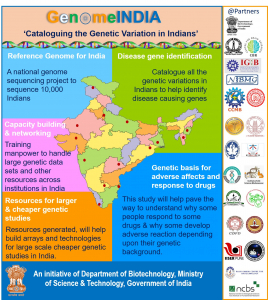Note4Students
From UPSC perspective, the following things are important :
Prelims level: Genome India Project
Mains level: Applications of Gene mapping

The Union Govt. has given clearance to an ambitious gene-mapping project, estimated to be worth Rs 238 crore.
Genome India Project
- The Genome India Project has been described by those involved as the “first scratching of the surface of the vast genetic diversity of India”.
- It involves over 20 scientists from institutions including the Indian Institute of Science (IISc) in Bengaluru and a few IITs.
- One of the most comprehensive genome mapping projects in the world is the Human Genome Project (HGP), which began in 1990 and reached completion in 2003.
- The international project, which was coordinated by the National Institutes of Health and the US Department of Energy, was undertaken with the aim of sequencing the human genome and identifying the genes that contain it.
- The project was able to identify the locations of many human genes and provide information about their structure and organisation.
What is Genome Mapping?
- According to the Human Genome Project, there are estimated to be over 20,500 human genes.
- Genome refers to an organism’s complete set of DNA, which includes all its genes and mapping these genes simply means finding out the location of these genes in a chromosome.
- In humans, each cell consists of 23 pairs of chromosomes for a total of 46 chromosomes, which means that for 23 pairs of chromosomes in each cell, there are roughly 20,500 genes located on them.
- Some of the genes are lined up in a row on each chromosome, while others are lined up quite close to one another and this arrangement might affect the way they are inherited.
- For example, if the genes are placed sufficiently close together, there is a probability that they get inherited as a pair.
- Genome mapping, therefore, essentially means figuring out the location of a specific gene on a particular region of the chromosome and also determining the location of and relative distances between other genes on that chromosome.
Applications
- Significantly, genome mapping enables scientists to gather evidence if a disease transmitted from the parent to the child is linked to one or more genes.
- Furthermore, mapping also helps in determining the particular chromosome which contains that gene and the location of that gene in the chromosome.
- Genome maps have been used to find out genes that are responsible for relatively rare, single-gene inherited disorders such as cystic fibrosis and Duchene muscular dystrophy.
- Genetic maps may also point out scientists to the genes that play a role in more common disorders and diseases such as asthma, cancer and heart disease among others.
- Researchers from several international institutions mapped the handful of genes whose mutation causes several different kinds of cancers.
Get an IAS/IPS ranker as your 1: 1 personal mentor for UPSC 2024

